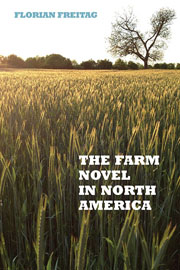 The Farm Novel in North America
The Farm Novel in North America Book contents
- Frontmatter
- Contents
- Acknowledgments
- Introduction
- 1 Surveying the Fields
- 2 Early Sowings: St. John de Crèvecocur's “History of Andrew, the Hebridean,” Patrice Lacombe's La terre paternelle, and Susanna Moodie's Roughing It in the Bush
- 3 Laws of Nature: Frank Norris's The Octopus, Albert Laberge's La Scouine, and Frederick Philip Grove's Settlers of the Marsh
- 4 New World Demeters: Willa Cather's O Pioneers!, Louis Hémon's Maria Chapdelaine, and Martha Ostenso's Wild Geese
- 5 Rich Harvests: Joseph Kirkland's Zury: The Meanest Man in Spring County, Claude-Henri Grignon's Un homme et son péché, and Frederick Philp Grove's Fruits of the Earth
- 6 Fields of Crisis: John Steinbeck's The Grapes of Wrath, Félix-Antoine Savard's Menaud, maître-draveur, and Robert J. C. Stead's Grain
- 7 The Cycle of Seasons: Louis Bromfield's The Farm, Ringuet's Trente arpents, and Grace Campbell's The Higher Hill
- Epilogue
- Works Cited
- Index
- Frontmatter
- Contents
- Acknowledgments
- Introduction
- 1 Surveying the Fields
- 2 Early Sowings: St. John de Crèvecocur's “History of Andrew, the Hebridean,” Patrice Lacombe's La terre paternelle, and Susanna Moodie's Roughing It in the Bush
- 3 Laws of Nature: Frank Norris's The Octopus, Albert Laberge's La Scouine, and Frederick Philip Grove's Settlers of the Marsh
- 4 New World Demeters: Willa Cather's O Pioneers!, Louis Hémon's Maria Chapdelaine, and Martha Ostenso's Wild Geese
- 5 Rich Harvests: Joseph Kirkland's Zury: The Meanest Man in Spring County, Claude-Henri Grignon's Un homme et son péché, and Frederick Philp Grove's Fruits of the Earth
- 6 Fields of Crisis: John Steinbeck's The Grapes of Wrath, Félix-Antoine Savard's Menaud, maître-draveur, and Robert J. C. Stead's Grain
- 7 The Cycle of Seasons: Louis Bromfield's The Farm, Ringuet's Trente arpents, and Grace Campbell's The Higher Hill
- Epilogue
- Works Cited
- Index
Summary
For roughly a century, novels set on farms, dealing with farming, and featuring farmers as their main characters simultaneously played an important part in the novelistic production of the United States, English Canada, and French Canada, constituting a veritable tradition in North American literatures. Given the length of this time span, perhaps the most striking feature about the North American farm novel is how little the genre changed in the course of time: The Farm (Bromfield [1933] 1961); Trente arpents ([1938] 1991); The Higher Hill (Campbell 1944); and the other farm epics of the 1930s and 1940s still portrayed the same types of farmers and engaged with the same national myths as the proto farm novels “History of Andrew, the Hebridean” (Crèvecoeur [1782a] 1962); La terre paternelle (Lacombe [1846] 1993); and Roughing It in the Bush (Moodie [1852/1871] 1995) a century—and, in the case of the United States, more than 150 years—before.
Fusing the historiographical discourses of the settler or pioneer and the well-established farmer with the national myths of the American dream, French Canadian agriculturalism, and English Canadian “Order and Control” in their depictions of farm life, these novels, however, not only contributed to the development of the nationally distinctive types of the American, English Canadian, and French Canadian farm novel. Much more importantly, joining rurality and national self-conceptions, they drew on and at the same time contributed to the spatialization of national myths and ideals and, conversely, the nationalization of the farm space in the North American imagination.
- Type
- Chapter
- Information
- The Farm Novel in North AmericaGenre and Nation in the United States, English Canada, and French Canada, 1845-1945, pp. 309 - 316Publisher: Boydell & BrewerPrint publication year: 2013


